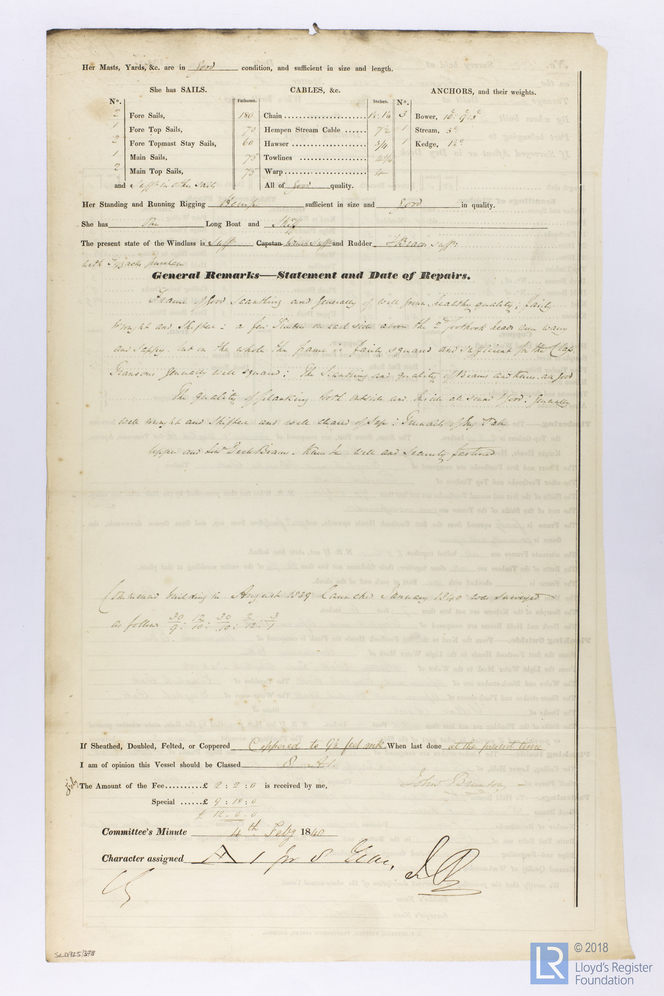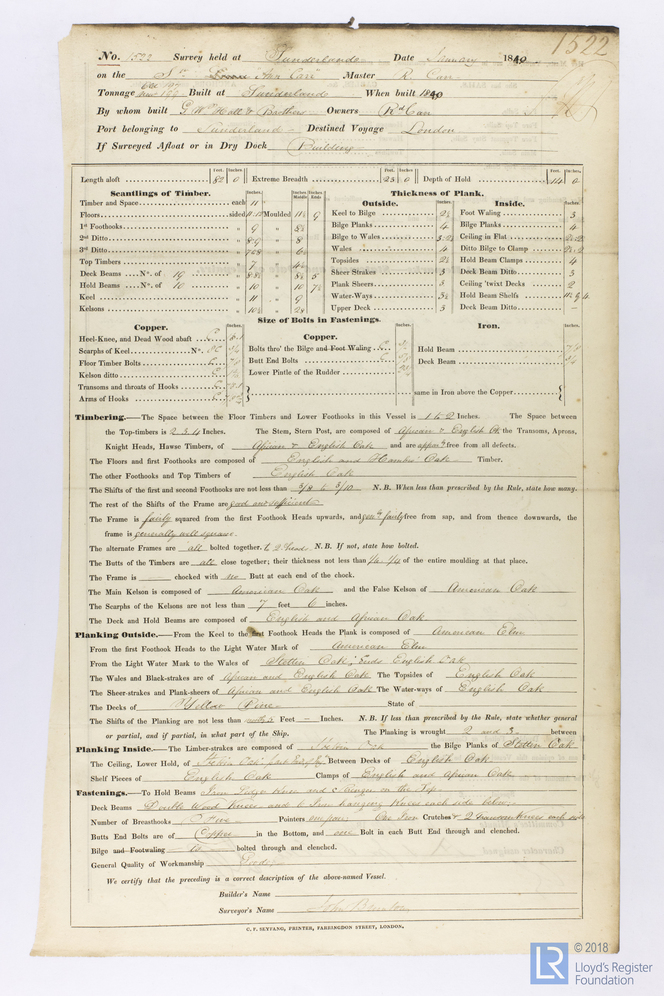- Related documents Related
- Full details Details
- Report document? Report?
Use the data export button to extract customised data sets from the Ship Plan and Survey Report Collection. Available in TSV and CSV formats.
Date recorded as the time of writing.
__/01/1840
The year in which a vessel’s construction is completed.
1840
The individual and/or organisation listed as having been responsible for constructing the vessel. This can/may be the same as the owner and/or manager.
G W Hall & Bros
The port or place in which the vessel’s construction took place, at the time of writing.
Sunderland
Abbreviations of the names of ports with Lloyd’s Register survey offices.
Sld
Official administrative title (often printed) of a record used by Lloyd’s Register or external organisations.
No title
The listed port to which a given vessel belongs.
Sunderland
The individual and/or organisation listed
R Carr
Name of the individual/entity/organisation responsible for authoring the record
John Brunton
Location where a vessel’s survey was undertaken.
Sunderland
Date of the meeting of the Classing Committee.
04/02/1840
Broad categories and subdivisions of vessels related to their purpose or function.
Cargo
A vessel’s means of propulsion.
Sail
Predominant material(s) utilised in a vessel’s construction.
Wood
System of admeasurement referred to as ‘Builder’s Old Measurement’ (BM or BOM) in place between 1786 and 1836.
197
Types of timber used throughout a vessel’s construction
AO - African Oak; EO - English Oak; HamO - Hamburg Oak; AmO - American Oak
Type of timbering specifically utilised for the vessel’s interior.
StO - Stettin Oak; EO - English Oak; AO - African Oak
Is machinery fitted at the aft of the vessel?
No
Generally a smaller additional auxiliary boiler (often used while the vessel is at port).
No
Name of the Proving House responsible for the public testing and certification of a vessel’s anchors and/or chain cables.
No
Physical extent of a record.
1
Name of ship as recorded on the record
Ann Carr
The process of transferring a vessel to water, but not necessarily her completion.
31/12/1839
The name of the yard where the vessel was built.
Bridge Yard
The country in which the vessel’s construction took place, at the time of writing.
United Kingdom
Unique internal numbers used for identifying, referring and retrieving a specific survey report.
1522
The country (flag) that a vessel is registered to, at the time of writing.
United Kingdom
Records that constitute Lloyd’s Register’s first official encounters with a specific vessel, e.g. a survey report.
Y
An officially licensed mariner (post 1850) holding ultimate command and responsibility for a vessel.
R Carr
Location where the document is written.
Sunderland
Classification symbol assigned to a vessel by Lloyd’s Register’s Classing Committee denoting the quality of construction and maintenance.
A1 for 8 years
The name of the port/place of destination given.
London
Physical arrangement of a ship’s masts, sails and rigging.
Sw - Snow
Type of fuel used onboard a vessel.
Sail - Rigs
Is the steamer assisted by sail?
No
System of measurement that replaced ‘Builder’s Old Measurement’, taking a vessel’s internal capacity as the standard. Vessels built between 1836 and 1854 were legally required to display both tonnages.
199
Type of timbering specifically utilised for the vessel’s exterior.
AE - American Elm; StO - Stettin Oak; EO - English Oak; AO - African Oak; YP - Yellow Pine
Confirmation as to whether the vessel was equipped with refrigeration machinery to aid in the transport of frozen or chilled cargo/goods.
No
Does the vessel possess an auxiliary power source?
No
Is electric lighting fitted to the vessel?
No
Measurement from the extreme outboard point of starboard to the extreme outboard point of port.
23'
Report an issue with this document
Have you noticed missing or incorrect data or images for this document?
Please let us know and we will rectify the issue as soon as possible.


